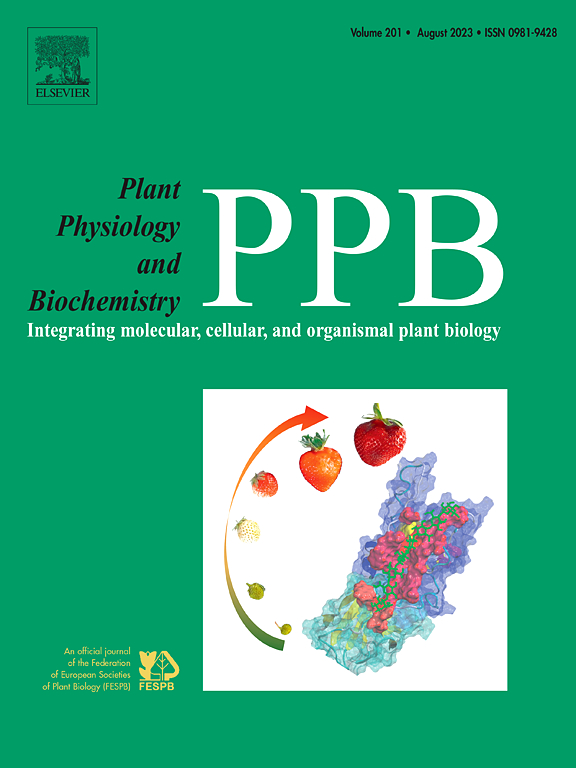Unveiling root growth dynamics and rhizosphere microbial responses to waterlogging stress in rapeseed seedlings
IF 5.7
2区 生物学
Q1 PLANT SCIENCES
引用次数: 0
Abstract
Waterlogging is a major abiotic stress that significantly alters ecological biodiversity and threatens crop growth and productivity. Rhizosphere microbial communities are essential for crop mineral nutrition and can help plants withstand stress. However, little is known about how rapeseed rhizosphere microbes respond to waterlogging and their link with soil nutrient availability and root architecture, and physiology. Thus, this study compared root morphological and physiological traits, soil physicochemical properties, and changes in rhizosphere microbial community composition and diversity using 16S rDNA and internal transcribed spacer (ITS) amplicon sequencing under waterlogging and normal conditions. The waterlogging stress induced a significant decline in root activity, growth characteristics, and content of nitrogen and potassium. In contrast, the phosphorus content of roots and shoots significantly increased. Rhizosphere bacteria richness and evenness decreased under waterlogging stress, which was associated with a significant decrease in soil available nitrogen, phosphorus, and potassium. In contrast, fungal diversity increased under waterlogging, concordant with increased soil organic matter content after five days. Notably, the bacterial phyla Proteobacteria and Firmicutes, and fungal phyla Ascomycota and Basidiomycota were identified as biomarkers under waterlogging. Interestingly, several Plant Growth-Promoting Rhizobacteria, including Pseudomonas and Rhizobium, increased under waterlogging conditions, indicating their potential for enhancing rapeseed mineral nutrition, growth, and tolerance. Besides, harmful fungi such as Fusarium solani increased under waterlogging conditions. Our results enhance our understanding of rapeseed response to waterlogging and the contribution of rhizosphere bacteria and fungi. Moreover, the current study provides theoretical bases for improving rapeseed waterlogging tolerance through soil management.
揭示油菜籽幼苗根系生长动态及根际微生物对涝渍胁迫的响应
内涝是一种主要的非生物胁迫,严重影响生态生物多样性,威胁作物生长和生产力。根际微生物群落对作物矿质营养至关重要,可以帮助植物抵御逆境。然而,人们对油菜籽根际微生物对涝渍的反应及其与土壤养分有效性、根结构和生理的联系知之甚少。因此,本研究利用16S rDNA和ITS扩增子测序技术,比较了涝渍和正常条件下水稻根系形态生理特征、土壤理化性质以及根际微生物群落组成和多样性的变化。涝渍胁迫导致根系活力、生长特性和氮、钾含量显著下降。而根和芽的磷含量则显著增加。涝渍胁迫导致根际细菌丰富度和均匀度下降,土壤速效氮、磷、钾含量显著降低。淹水后真菌多样性增加,与土壤有机质含量增加一致。其中,变形菌门和厚壁菌门细菌门、子囊菌门和担子菌门真菌门被鉴定为涝渍生物标志物。有趣的是,几种促进植物生长的根瘤菌,包括假单胞菌和根瘤菌,在涝渍条件下增加,表明它们有可能提高油菜籽矿质营养、生长和耐受性。此外,在涝渍条件下,有害真菌如枯萎菌增多。本研究结果提高了我们对油菜籽对涝渍的响应以及根际细菌和真菌的贡献的认识。此外,本研究为通过土壤管理提高油菜籽耐涝性提供了理论依据。
本文章由计算机程序翻译,如有差异,请以英文原文为准。
求助全文
约1分钟内获得全文
求助全文
来源期刊
CiteScore
11.10
自引率
3.10%
发文量
410
审稿时长
33 days
期刊介绍:
Plant Physiology and Biochemistry publishes original theoretical, experimental and technical contributions in the various fields of plant physiology (biochemistry, physiology, structure, genetics, plant-microbe interactions, etc.) at diverse levels of integration (molecular, subcellular, cellular, organ, whole plant, environmental). Opinions expressed in the journal are the sole responsibility of the authors and publication does not imply the editors'' agreement.
Manuscripts describing molecular-genetic and/or gene expression data that are not integrated with biochemical analysis and/or actual measurements of plant physiological processes are not suitable for PPB. Also "Omics" studies (transcriptomics, proteomics, metabolomics, etc.) reporting descriptive analysis without an element of functional validation assays, will not be considered. Similarly, applied agronomic or phytochemical studies that generate no new, fundamental insights in plant physiological and/or biochemical processes are not suitable for publication in PPB.
Plant Physiology and Biochemistry publishes several types of articles: Reviews, Papers and Short Papers. Articles for Reviews are either invited by the editor or proposed by the authors for the editor''s prior agreement. Reviews should not exceed 40 typewritten pages and Short Papers no more than approximately 8 typewritten pages. The fundamental character of Plant Physiology and Biochemistry remains that of a journal for original results.

 求助内容:
求助内容: 应助结果提醒方式:
应助结果提醒方式:


